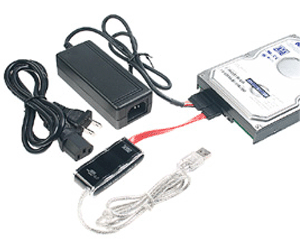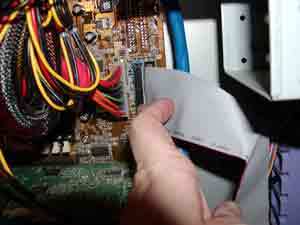Question: My dell 8400 tower went down, replaced power supply and ..nothing. How can I get everything off the hard drive, install into another tower, or take it somewhere to download to external drive?
Question: My dell 8400 tower went down, replaced power supply and ..nothing. How can I get everything off the hard drive, install into another tower, or take it somewhere to download to external drive?
Answer: From what you’ve described, it sounds like your motherboard is probably fried. Since the Dell 8400 series run an old Pentium 4 processor, it’s probably not even worth bothering with trying to replace the motherboard – you’re better off trying to get the data off the hard drive and just replace the system altogether.
You have a few options for doing this. I’ll cover the easiest way first, which is to use a transfer utility program called Zinstall, to move data from your old hard drive and copy everything over to a new hard drive – including your programs, settings, contact, files – the whole works. Your new computer will feel just like the old one… only a lot faster since your new system will have a lot more horsepower.
The nice things about Zinstall is that you don’t have to be a computer guru and you don’t need any cables. The product is completely automatic and intuitive to use (video below) and if you can connect both computers to the Internet, then you are all set – nothing else is needed.
That means you won’t have to wait for the software to be shipped to your location. Just download it, and start transferring.
Zinstall works with Windows 10, Windows 8/8.1, Windows 7, XP and Vista, any edition, 32- and 64-bit. You can transfer from any Windows to any Windows, any PC model to any PC model. XP or Vista to Windows 10, 7 to 10 or even Windows 10 to Windows 10 are all supported.
Here’s a short video that walks you through the process:
You can also hook up the old hard drive as a slave drive in your new system, or you can use an IDE adapter that plugs into a USB port and treats your hard drive like an external USB drive.
Either way you’ll need to remove the hard drive from your old system, which is easy to do. Remove the screws from the outer casing (some cases let you slide the side off without removing screws) and locate the hard drive. There will be a flat thin cable about 2 inches wide connecting it to the motherboard.
Remove the screws holding the hard drive to your case (usually 2 on each side) and then remove all cables and power cords going into the hard drive.
IDE Adapter
This approach lets you copy data from your old hard drive onto another desktop system or laptop is to connect it using an IDE adapter, but it won’t let you copy programs (since programs include settings that are stored in the registry).
The adapter will connect your hard drive with your other system’s USB port, and will let you copy files over just like it was a USB flash drive. The IDE adapter I have is the Sabrent DSC5

Once you connect the hard drive with the USB port on your other system, restart the other system and it will power up your hard drive and recognize it as an additional drive in Windows Explorer (or Finder on Macintosh systems). You’ll be able to drag files and folder from the old hard drive to your new system.
Slave Drive
You can also install your old hard drive into your new system as long as there is room in the desktop case for another hard drive, and as long as there’s an available IDE or SATA connector on your motherboard.

Most newer systems use SATA (the small red cable shown in the adapter image above), but they should also have an IDE connector on the motherboard that you can plug your old drive into. When you restart the system it should recognize it as an additional hard drive (D drive if no other drives or CD/DVD drives are installed) and you’ll be able to copy files and folders over just like with the IDE adapater approach mentioned above.
Out of all three options, Zinstall is the only option that also transfer your installed software programs.

Sata
I have a device like you mentioned – but when I attach it to my new HP pc with Windows 7 it adds it under device manager, but not in windows explorer. Since it was formatted and used in Windows ME, could there be a format issue, like 32 bit vs 64 bit? Would a disk drive enclsure work better?